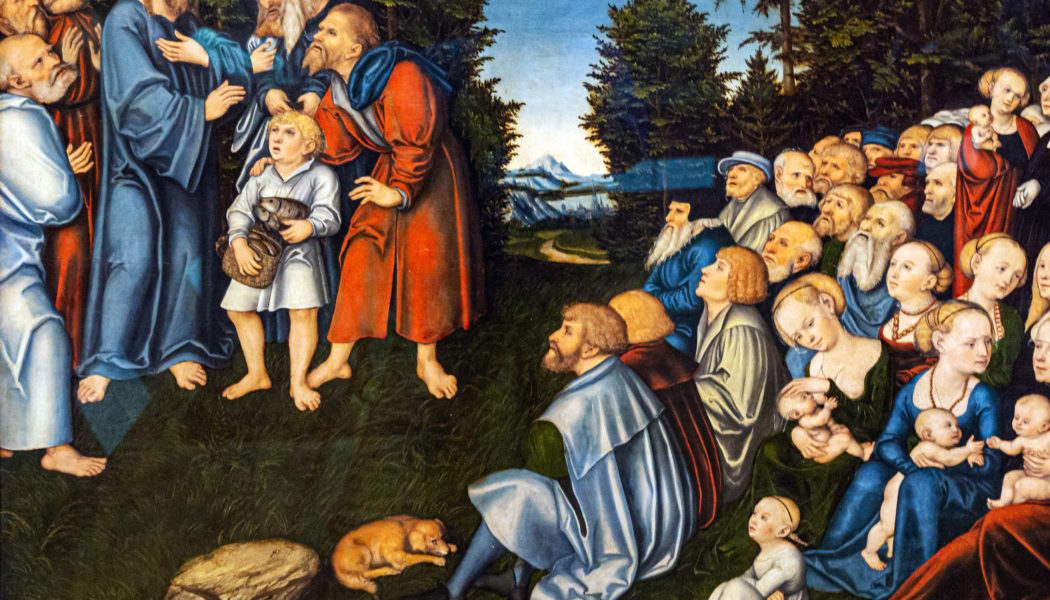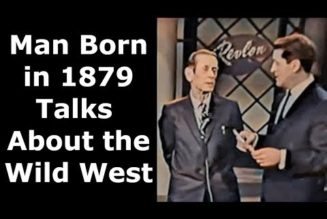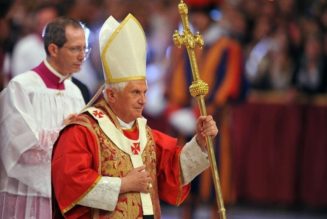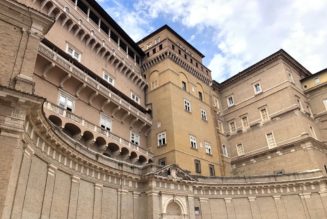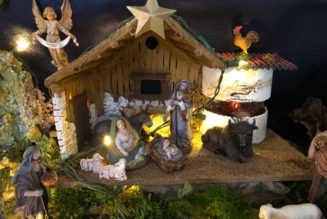Today, Catholics in the United States celebrate the Solemnity of Corpus Christi (which most of the rest of the world celebrated last Thursday).
Corpus Christi is especially important after the 2019 Pew survey suggested there were real problems with the understanding of Christ’s presence in the Eucharist among Catholics in the United States. What should have been a wakeup call has led to some kind of program of Eucharistic focus by the American bishops, the “National Eucharistic Revival,” set to launch today.
I hope that your parish is taking real action to restore the cult of Eucharistic devotion for the local faithful. Being Corpus Christi, there is hopefully some Eucharistic procession occurring at your parish. Many parishes have revived the traditional “40 Hours Devotion,” providing what can be a focused, retreat-like opportunity to grow closer to the Eucharist. Once upon a time, dioceses used to coordinate the devotion in such a way that some parish somewhere in the diocese was celebrating Forty Hours each week. Many parishes have provided Eucharistic adoration on a regular basis each week. Some have rediscovered “Nocturnal Adoration,” the practice of exposition of the Blessed Sacrament from the evening of First Friday to the first Mass of Saturday, with various groups taking hour rotations through the night in church. Others have recognized the altar rail is not just an obstructive relic and returned to receiving Communion at it, which encourages a more reverent posture of kneeling.
Today’s Gospel (Luke 9:11b-17) focuses on Jesus’ multiplication of five loaves and two fishes. The importance of this episode is underscored by the fact that it is substantially repeated by the other two Synoptics (Matthew 14:13-21, Mark 6:30-44) as well as John (6:1-15). Indeed, in John the multiplication of the loaves is merely the prelude (what a prelude!) to the greater miracle, which is Jesus’ foretelling of the Eucharist as the essential Bread of Life without which man cannot live — a teaching that results in some of Jesus’s followers “turning away” (vv. 60-67) from this “hard teaching.” Jesus does not dilute his Teaching: he even asks the Apostles if they want to leave rather than follow it. That gives you a sense of the centrality Jesus attached to what he said about the Eucharist (and why, on this Solemnity of Corpus Christi, you might want to read the entirety of John, chapter 6).
Today’s Gospel tells us that Jesus has been teaching a large crowd, at least 5,000 men. They’ve stayed with him, they’re tired, and they’re hungry. The Apostles’ first reaction is to slough the problem off: cut the homily short, Jesus, “dismiss the crowd,” close the place up and send the people off so they can fend for their own food and shelter.
That’s not Jesus’s way. He tells the Apostles: “Give them some food yourselves.” These stewards of their resources measured their possibilities not by what Jesus might empower them to do but by a simple, bottom-of-the-ledger pragmatism: “Five loaves and two fishes are all we have.” (In John 6:9, it’s not even the Apostles’ bread and fishes — Andrew found a kid with some food). Still not seeing what they could do with faith in Jesus, they continue with their pragmatic calculations, noting their meager rations are it “unless we ourselves go and buy food for all these people.” (John 6:7 adds that Philip already anticipates the cost will far exceed whatever was in the Apostles’ Annual Appeal). Jesus (who, in John 6:6 “already had in mind what he was going to do”) turns the Apostles into ushers, having them sit the crowd down in groups of 50 (which would mean about 100 such groups).
Note carefully Luke’s next words, which exactly mirror what Jesus did at the Last Supper: “taking the five loaves and the two fish, and looking up to heaven, he said the blessing over them, broke them, and gave them to the disciples …” These are Eucharistic words.
The Apostles are to distribute this bread (no extra ministers to avoid “undue prolongation” of the process?), a bread by which they were “satisfied.” In John 6:27 and 31-40, Jesus also notes that his bread, his flesh, is the only lasting satisfaction, “unlike your ancestors, who ate manna and died” (6:58). This is the same satisfaction of which he spoke to the Samaritan woman when he promised her “living water,” which she wanted first of all to eliminate the drudgery of drawing water daily at Jacob’s Well (John 4:15).
When the Apostles gather what was leftover, there were “12 wicker baskets.” Why 12? Because (a) the surplus of leftovers compared to the meagerness of the offering already testifies to divine largesse; (b) 12 was a number of perfection in Hebrew; and (c) 12 corresponds to the Apostles, who are to feed these people and distribute this bread, not as some utilitarian process to address Judean hunger but as a part of their very Apostolic identity.
What happened in the multiplication of the loaves is a miracle. I stress that because the Eucharist, too, is a miracle. Indeed, in their new book on the Eucharist (Behold It Is I!)authors Trasancos and Elliott make a case that Jesus’ walking on water (John 6:16-24) — right in the middle of John’s Eucharistic chapter —also reinforces the miraculous dimension of the Eucharist. Jesus wants to make clear that if you think multiplying loaves and walking on water are miracles, wait till you hear what I’m going to tell you about “the Bread of Life.”
I emphasize that the multiplication of the loaves is a miracle because there are various Biblical exegetes who try to water down the significance of this event by suggesting that Jesus’ generosity simply caused people to share the food they had so that “all had enough,” thus eviscerating any idea that Jesus provided for people in their poverty. Jesus provides what man cannot.
The multiplication of the loaves prefigures what Jesus would institute at the Last Supper and, because it happened during Jesus’ public ministry, it was relatively chronologically close to that event. But God had been planning for the Eucharist a long time before — indeed, in the Book of Genesis, as today’s First Reading shows.
(Genesis is the first book of the Bible but, already, God is prefiguring important moments in salvation history there. Even in the Garden of Eden, he promises a Savior and a new woman who would crush the Devil’s head. He prefigures the Trinity in the visitors to Abraham’s tent who promise him a son, and he prefigures the Son whom Abraham’s son prefigures in Isaac’s almost being sacrificed. And, today, we have a prefigurement of the Eucharist).
Melchizedek is a mysterious figure, a priest and king who simply appears in this episode and then disappears. Abraham has just defeated four local kings, from whom he has taken booty. He offers tithes of that booty to Melchizedek, which acknowledges he is someone greater than merely Abraham’s peer (since the Levitical priesthood of Israel would also come from Abraham’s loins). His name is “king of justice,” and he rules over a city of peace, known today as Jerusalem. The Letter to the Hebrews picks up all these points about Melchizedek to see in him a type of Christ prefigured, especially in this giving of bread and wine to Abraham. (On Melchizedek, see here.)
Today is a two-fer in terms of sacred art illustrating the readings. The Gospel is illustrated by Lucas Cranach the Elder (c. 1472-1553). Cranach was a German Renaissance painter, probably best known for numerous paintings of Martin Luther. His “Miracle of the Five Loaves and Two Fish” most faithfully depicts that event according to John, e.g., a little boy with his pouch of bread and two fishes under his arm is introduced to Jesus. That Cranach painted the miracle according to John is paradoxical, because Protestants in general do weird things when it comes to John 6 — whereas they insist almost always on literal readings of Scripture, they suddenly adopt a “symbolic” interpretation of John 6 to accommodate their denigration of the sacrament. (Cranach followed Luther, and Luther did not go as far as subsequent Protestant leaders in reducing the Eucharist to a mere symbol, though he did concoct a theory called “consubstantiation” which said basically that the Eucharist is Christ and is bread, too, so that Swiss Protestant Ulrich Zwingli rightly ridiculed Luther’s “bread God.”)
The focus of the painting is a bit fluid (though I am sure Cranach would reject my interpretation). Certainly the focus is on Jesus. But Jesus is also focusing on the bread and fish born by the boy, whose frontal pose (the most prominent one in the painting) also attracts the eye to him and his offering. Certainly all the Apostles and most of the crowd — two distinct camps, divided by direction in which people are looking and a green swath of grass — are focused attentively on Jesus. The portrayal of the crowd might be deemed by contemporary standards as a bit sexist because, as the Gospel notes there were 5,000 “men” (women and children not being counted in that cohort) the women in the audience are depicted as distracted by maternal cares, in comparison to the male attention to Jesus and what he might do.
Cranach was a representative of the German Renaissance which, unlike its Italian counterpart, retained certain late Gothic styles of depiction. We have a sense of that in the faces and poses of the people in Cranach’s painting, even if the members of the crowd (in contrast to Jesus and his apostolic group) are clad as 16th-century Europeans and elements of nature intrude in ways they would not have in pure Gothic art.
The First Reading is depicted by Flemish Baroque artist Peter Paul Rubens (1577-1640). Rubens lived and worked almost a century after Cranach and used his artistic talents in service of the Counter-Reformation. This work was actually part of a series of tapestries on “The Triumph of the Eucharist” for a Spanish convent. When we speak of Rubens as “Flemish,” we are referring to what is today called Belgium, which in his day was ruled by Spain. Spain also ruled provinces to the north, but their push for independence, secured around 1581, was driven by their Protestantism: that area is today the Netherlands.
If Cranach’s painting is very static — two groups waiting tensely for something to happen — dynamism effuses Rubens’ work. The movement of Abraham and his party rightwards converges with Melchizedek and his people leftwards, bringing into the very center the bread and wine Melchizedek has just passed into Abraham’s hands. (Even the spear behind Abraham, seemingly pointed in the opposite direction as a sign of peace, leads us by its line right down to the bread and wine.) Presumably, Melchizedek’s people are receiving Abraham’s tithes at the bottom, while angels look down at this first version of the “Bread from Heaven.” As the National Gallery of Arts’ commentary notes of Abraham and Melchizedek, “they lock eyes as though they have a premonition, unshared by the others, that the bread and wine have significance beyond bodily sustenance.”
Abraham has just been in struggle with four local kings and so he and his party are in military dress, including armor. I must admit I do not know how anachronistic that depiction might be. Abraham lived in the Bronze Age, and smelting iron was more than 800 years in his future. Rubens’ armor looks more like the armor of his day rather than Abraham’s. It certainly doesn’t look bronze and I do not know whether bronze armor existed in Abraham’s area of the Near East in his day.

Join Our Telegram Group : Salvation & Prosperity
